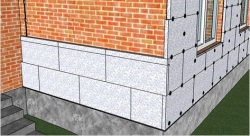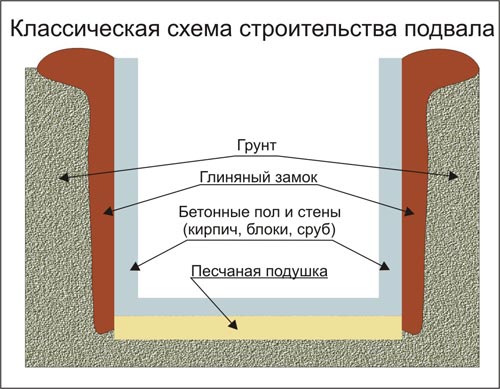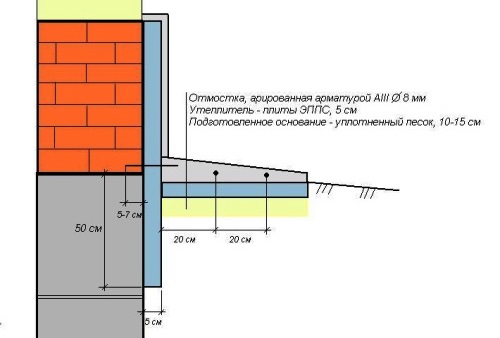How to score a nail?
This question, it would seem, should know the answer everyone ...
|
How to score a nail? This question, it would seem, should know the answer everyone ... |
Modern housing, in our view, is a harmonious combination of the magnificent ... |
Garage insulation is a kind of key to the long life of your car. Sharp ... |

The basement insulation is of great importance. This allows you to reduce the heat loss of the house, reliably protect against dampness and destruction due to frosty swelling of the soil of the wall. Even if you do not plan to heat the insulated basement, the temperature in it will not drop below 10 degrees above zero. The price of insulation materials is not too high, so you will not spend a lot of money when performing the basement of the basement with your own hands.
Table of contents:
Each building has a basement, which is a space between the ground and the overlap. The basement usually has a completely comfortable height, which allows you to arrange rooms of economic purpose. The height of this room depends on the height of the basement and the size of the foundation and is at least two meters, so it is simply not to use this space is irrational.

Today, the basement is not just a cellar for storing fresh vegetables and conservation in the winter season and the maintenance of a working tool. People begin to live underground buildings. Garages, saunas, baths, rest rooms and gyms are located here. The arrangement of wine cellars is very popular. The arrangement of the basement provides excellent possibilities for using large areas without the construction of complex multi -meter structures.
It is known that the temperature at a depth throughout the year has stable indicators, but it is far from optimal. To bring this indicator to the norm, you should find out how to properly insulate the basement, and do this work, which will allow this room to use with benefit.
Thermal energy, which could be directed to heating living space, heats the unscheduled basement, increasing the consumption of gas, electricity or other coolant. Without insulation of the basement, you will pay for unnecessary excess. The insulated dry basement reduces the loss of thermal energy by almost 20%, and also saves the walls of a residential building from dampness.
In addition to savings, there is another reason for insulation of the basement by polystyrene, polystyrene or mineral wool. It is believed that the floor temperature should not drop lower than 3 degrees from the indicator of the residential area. However, the floor slabs are common for the rooms of the first floor and basement. And if the cold of the basement does not cool the floor (cold air creeps below), in this case the legs will be comfortable and warm.
It is customary to insulate the basement in different ways, but the most effective is the insulation of the basement from the outside. With this technique, thermal insulation material is mounted outside, thereby preventing the freezing of the basement walls. With internal insulation, condensate is formed at the joints of the insulation and walls, and this spoils the entire coating.

Therefore, do not forget about thorough waterproofing of the entire surface of the walls. Choose such a thermal insulation material that tolerates moisture well. A great option for these purposes is to warm the basement with foam. Of course, it is best to warm the basement at the stage of construction of a residential building, because in such work at this time you can combine with the waterproofing system and the drainage system.
Before warming the basement and its walls, it is necessary to achieve their ideal evenness, after which it is worth processing using antifungal and antiseptic impregnation. Humidity in the basement after the insulation work may increase, and to avoid the occurrence of this problem, it is recommended to worry in advance about the proper drainage, drainage and ventilation of the walls.
For ventilation of the basement, it is customary to equip special holes in the basement, which are located from each other at a distance of 5 meters. You can close them only with severe frost. To create a drainage system, you can install drainage membranes, lay drainage pipes or install expanded clay filler.
After that, dig the underground part of the foundation on the outside, cover with a glass wool with a grid or put on hollow bricks. You can additionally make drainage backfill along the wall. If, after the dug soil is returned, the material is still noticeable, it can be covered with brick masonry or tiles.
Protects from atmospheric precipitation by a blind area made around the perimeter of the structure of concrete or asphalt. Its goal is to remove rain or melt water from the foundation. When creating a blind area, pay special attention to the joints with the wall of the structure. Another solution of protection against groundwater is a clay castle.
If you are interested in how to insulate the basement with your own hands, then remember that the whole process boils to three directions of insulation of walls, floor and ceilings. Overlating insulation is recommended only when the temperature in the basement is lower than throughout the house. The work begins with a neat seal of all joints, cracks and cracks.
In the case of using pins and metal nails, you need to cover them from the basement with a heater, because such metal elements can create cold bridges, through which a lot of heat goes from a warm room. Put between the floor of the first floor and the basement of the insulation and fix it.
Of course, such manipulations can reduce the height of the basement, but the floor in the living rooms will become warm. After insulation of the floors, you need to worry that the condensate does not fall out. Do not forget that water vapor is moving through the flooring for the floor, which needs to be prevented.
To do this, install a vapor barrier on both sides of thermal insulation material, this will protect the insulation from getting wet, rotting and molding of mold. On the part of the basement, insulating materials are customary to protect with an external trim, which can be plaster, paintwork or panels.
The floor insulation in the basement is appropriate only if the underground room is desired. This part of the construction is affected by increased humidity and low temperatures. The installation of a warm floor system is able to create more comfortable conditions for being in this room.
It is impossible to neglect the stage associated with the leveling of the concrete base and laying waterproofing. This issue is especially acute in the spring, when, due to the abundant melting of snow, the groundwater level rises significantly, often reaching the surface of the earth. Lay the waterproofing material on the walls and horizontal plane. Any sheet bitumen material, for example, is suitable for roofing material.

Remember that regardless of how to insulate the basement of the house from the inside or outside, thermal insulation of the floor in the room should maintain its properties in full for several decades. For these purposes, extrusion foam with closed pores, which is 100%waterproof, is best suited.
If you plan to equip the basement as a billiard or dwelling, then you can not do in this case without wall insulation. If you have made your choice in favor of insulation of the basement with foam, then you should find out about the advantages and disadvantages of this material in order to be used with maximum benefit and efficiency.
Among the advantages, the following are distinguished:

Now you should look at the shortcomings:
Foam is allowed to be used exclusively in high fire safety rooms. Taking into account such characteristics, one can judge how to insulate the basement from the inside, and whether this material is suitable for insulation of the basement in each certain case.
For insulation of the basement walls, it is best to take 25 density foam. It is desirable to have quarters along the edges, which contribute to a tight joint of sheets. This also applies to situations when the mount is made minimal. Make waterproofing as the first layer, the waterproofing material is placed on a pre -prepared surface. Sheets of insulation are customary to be attached with adhesive composition.
After laying out the entire surface with foam, you need to make a cement screed on top, which has a thickness of 50 millimeters. In order for the screed to get good strength, you need to reinforce with a net, which has 5-millimeter cells. For screed, cement m 100 is suitable. If you operate the cement screed on the walls, then this is how the soil pressure on the thermal insulation material can be reduced.
After this work, it will not be superfluous to create another layer of waterproofing, since the cellar or basement is a very raw room. The finished surface after this must be lined with tiles, depending on the purpose of the room.
If the foundation in your house is made multilayer, then for insulation of the basement, in addition to foam, you can use mineral wool, but this material requires the creation of damage protection. When warming the basement walls with the help of any insulation, it is recommended to close the joints that form the bridges of the cold.
Now you know how to insulate the basement with your own hands. There are two internal and external methods. Which of them to choose a solution for you. However, remember that you need to warm the floor, walls and the basement. At the same time, the creation of waterproofing and drainage system is of great importance, since the basement is classified as very raw rooms, and it needs not only insulation, but also protection against moisture.
When designing heating networks, it is worth considering all the features. PPU PPUs Price are just ideal for these purposes. Additionally, the insulation of pipes and pipelines of PPU will increase the pipe service.
i was offended with polystyrene
i was offended with polystyrene